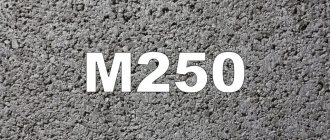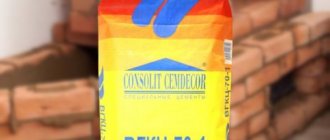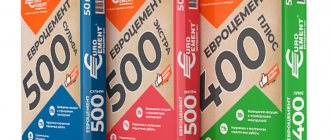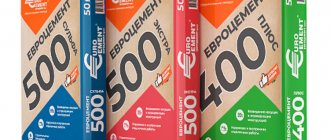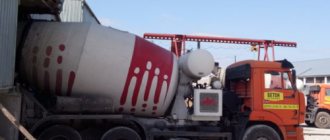Cement M500 D0 is a building material that is made from pure clinker and meets the requirements of GOST 31108-2003. Portland cement does not contain any synthetic additives, but calcium silicates predominate. The material is very popular in the market due to its strength - it can withstand a load of at least 500 kg/cm2.
PC 500 D0 is used for making road surfaces, creating bridge supports, pouring screeds, and constructing monolithic buildings/structures. Based on this type of cement, mixtures/solutions are prepared that guarantee very high strength indicators, so the material is relevant where there are heavy loads.
M500 grade cement without additives is actively used in the industrial production of the most durable monolithic/prefabricated, stressed structures. PC 500 cement is suitable for use in hydraulic engineering, road and airfield construction. In private construction it is used to create high-quality concrete mixtures for a variety of jobs.
General characteristics
M500 cement, the price of which is relatively low, is produced in accordance with GOST 10178-85.
The following raw materials are used for its production:
- Gypsum stone.
- Clinker. This is a mineral that is obtained by sintering limestone and clay.
- Blast furnace charge.
- Various active additives that are used to improve the properties of cement. They can be hydrophobic, plasticizing, acid-resistant.
All components are finely ground and mixed in a certain proportion. Index 500 in cement marking means that the material can withstand a weight of 500 kg per 1 square centimeter. Solutions made on the basis of this brand are quite resistant to low temperatures, and upon hardening their shrinkage is insignificant, which significantly reduces the risk of cracks in the body of the structure.
Cement M500 technical characteristics have the following:
- Frost resistance - F70. This is a very important parameter. The ability of M500 cement to withstand repeated freezing and thawing is achieved by adding various modifying additives to its composition.
- Flexural strength 6.4 MPa.
- Setting period is approximately 50 minutes.
- Compressive strength 59.9 MPa.
- Expansion during setting - 10 mm.
- Grinding fineness 92%. This characteristic can have a direct impact on the setting and hardening time of the solution, as well as its strength.
- Radioactivity is 370 BC/kg.
- M500 cement has the most positive technical characteristics. Concrete and mortars based on cement 500 are highly resistant to corrosion and aggressive environments. Such mixtures are recommended for winter concreting. M500 cement has the following proportions when used in domestic construction: 1: 3: 6, where there is 1 part of cement, 3 sand and 6 aggregates. It should be remembered that you cannot mix M500 cement with other brands, as the characteristics of this material will sharply change for the worse.
Cement d0 and d20 difference
This process begins after the setting itself has completed. After all the mortar has been laid and the cement has set, the hardening process begins.
But how long does this process take for applications contained in the manual for bagged cement? It is about one month.
But in fact, this process continues for several years. The time indicated on the packaging is enough for the concrete to reach a certain grade, which is declared by the cement manufacturer.
Buying cement is currently not difficult, because alumina cement in Minsk is sold in any construction hypermarket.
After 2 days of being wet in the plastic bag there should be no cracks.
With poor cement, the disc will crack and break in your hands. PC grade M is sold in bags or in bulk - in wagons or cement trucks at wholesale prices. This is due to the size of the purchase.
Considering the retail market, the price, depending on the manufacturer and brand of cement, ranges from up to rubles per 50 kg bag. But it is worth remembering that if you buy 50 kg of such Portland cement, you will bring kg of brand cement to your dacha, and, possibly, To obtain cement with the desired properties, various additives are introduced into its composition. If you compare cement D0 and D20, there will be a difference both in composition and in the area of use.
How to decipher cement markings
Thanks to additives, the material acquires additional useful qualities, among which are resistance to the following factors: If we compare cement D0 and D20, then in the first case the material will consist entirely of cement clinker. Cement without additives is characterized by strength and speed of hardening. Its modification D20 is produced in stages and represents a homogeneous powdery mass of clinker and certain substances.
Density of cement M500
The density of cement is the ratio of the mass of the material to the volume. It can be true and bulk. According to technical data, density is a partial measurement of the mass of grains of a given substance relative to its volume (pores and air voids are not taken into account).
M500 cement has the following technical density characteristics: depending on the area the surface occupies, it is approximately 3000/3200 kg/m3.
The bulk density of the material in a loose state is 1100/1200 kg/m3.
When compacted it is 1500/1600 kg\m3.
At large facilities, when calculating, the average density of M500 cement is generally taken - 1300 kg/m 3.
Additives
They are designated by letters that appear at the end of their names. The most common of them are:
- PC - Portland cement.
- B is a fast-hardening cement. It is used in emergency situations.
- ShPC – slag Portland cement. The added letter "Ш" means that the additive threshold exceeds 20%.
- N - production includes a strictly dosed amount of clinker.
- PL - due to the introduction of plasticizers, the frost resistance and elasticity of the material increases.
- GF is a hydrophobic grade that is waterproof.
- SS - sulfate resistant. Resistant to aggressive liquids and substances.
- VRC is waterproof and quick-setting. Used for sealing seams, joints, cracks.
Types and their characteristics
This brand of cement differs in the presence or absence of mineral additives. There is a building mixture that does not contain additives, which is marked with the symbols D0 (that is, additives - 0) and there is a variety that includes mineral additives in an amount of up to twenty percent of the mixture and is marked accordingly - D20.
The technical characteristics of the M500 include:
- strength,
- the presence of frost resistance and resistance to low temperatures,
- manifestations of minor deformations during the shrinkage process,
- water resistance,
- reduced sulfate resistance.
These characteristics should be supplemented with high anti-corrosion resistance, which is observed in the variety with mineral additives. This property determines the use of this variety in repair and construction work, plastering work and use as an addition to mixtures that require corrosion resistance.
Special types of cements
Considering the active use in various fields, manufacturers offer mixtures specialized for specific tasks:
- Quick-hardening Portland cement acquires more than half of its brand strength within three days, is used in high-speed construction, and is labeled BTC.
- Sulfate-resistant M500 is used in massive foundations that are exposed to groundwater containing sulfates, in particular for piers, dams, and is marked with SSPC.
- Mixtures with surfactant additives have better plasticity (PL marking) or reduced water permeability (GF marking), which make it possible to use them in specific conditions.
- Waterproof expanding cement has a high density and is used for waterproofing mine structures, water pipes and sealing cracks in reinforced concrete structures, it is marked with VRC.
- Portland cement cement is used to isolate boreholes from groundwater.
- For decorative purposes , in particular the laying of facing bricks or facade stones, colored cements or white cement are used, which are marked with the letters BC.
Additives and additives
The presence of additives can be determined by the labeling on the packaging. To determine the number of additives, the letter D is used, followed by the percentage of additives. As a rule, additives are contained in the range from 5 to 20 percent, respectively, there are markings from D5 to D20.
In addition, the marking code uses other letters to indicate modifications of mixtures that are supplemented with additives.
There are a significant number of such letters; their definitions are given below:
- B – quick-hardening mixture;
- ShPC – contains more than 20% additives, Portland slag cement;
- PC – Portland cement;
- N – mixture with a normalized amount of clinker;
- PL – plasticizers, that is, the mixture has increased frost resistance and plasticity;
- GF – hydrophobic, that is, it is waterproof;
- VRC – has zero water absorption, quickly hardens;
- SS – sulfate resistance, resistant to aggressive liquids.
The use of various additives and additives makes it possible to obtain cements with certain properties. Thanks to this technology, it is possible to use the M500 in a variety of areas and achieve significant material savings.
Cement M500 - application
Based on this material, high-quality building mixtures are made, such as heavy concrete, masonry and plaster mortar. A distinctive feature of finished structures is strength, stability, and durability. Cement is widely used in the most critical construction sites:
- For pouring foundations for multi-storey and industrial buildings.
- For the construction of public and industrial buildings and premises that experience increased load (for example, shopping centers, train stations, large warehouses or port docks).
- For emergency repairs and restoration of reinforced concrete and concrete structures. The characteristics of the material allow the work to be completed in the shortest period of time and with proper quality.
- For the construction of hydraulic structures such as dams, bridges, dams, locks.
- Used in the construction of expressways and roads, etc.
Now M500 cement, the price of which depends on the volume (wholesale or retail) and starts from more than 200 rubles per bag (50 kg), has increasingly become used for the manufacture of Euro fences, paving slabs, and gas silicate blocks.
Source
What is the difference between cement D0 and D20?
In options D0 and D20, cement grades M500 and M400 are mainly used, also known as “five hundred” and “four hundred”, respectively.
It is intended for masonry and plastering work, and is used in pouring foundations, producing structures, beams and concrete floor slabs, in residential and industrial construction. The marking “M500” means that this cement can withstand a load of 500 kg per cm 2 of the area of the finished product. And the D0 and D20 markings show the percentage of clinker additives in the composition of the material.
There are no additives in the cement mixture of grade D0. This is pure clinker. And D20 is characterized by 20% modifying additives in its composition.
What is clinker and what does cement consist of?
The lion's share of the composition of the cement mixture is occupied by clinker - a special mass that is made from high-quality limestone and clay. After firing at a temperature of 1450 degrees, this raw material turns into a powdery mass. It, in turn, is cement - or it forms bonds in concrete after mixing and hardening. Gypsum is also sometimes added to it, but not more than 1% of the volume, so as not to change the performance properties of the material.
During the production of some brands, special modifying additives are introduced into the mixture. They change the properties and performance of the material. However, in some cases during construction, these “additives” are undesirable, and a cement composition with them is used primarily for finishing and structural work, for which high strength is not needed.
There are no modifying additives in grade D0 cement; it consists only of clinker and, in some cases, gypsum. This material is characterized by the highest strength, excellent frost and moisture resistance, as well as maximum durability. “Pyatisotka” with D0 can withstand not only nominal loads of 500 kg per m 2, it can cope with more.
D20 contains 20% modifying “additives”. As a result, it has lower strength, lower solidification rate and other performance qualities.
The main difference between D0 and D20 cement
The main difference between these brands is the scope of use. So, regarding the “five hundred”:
M500 D0 is used in the construction of large industrial buildings, bridges, airfield pavements and similar heavily loaded structures where high strength is critically required;
M500 D20 is used in the construction of private houses, in finishing works and in the casting of monolithic products.
M400 D0 is used in private construction, the construction of industrial facilities, for the manufacture of monolithic and prefabricated structures;
M400 D20 is used in the production of concrete structures.
Thus
When choosing cement, it is worth assessing the planned use - and then starting from it when selecting a brand.
Why are supplements needed?
It would seem that if all these “additives” so degrade the performance of finished concrete structures, why introduce them at all? However, they are not included in the mix to reduce the cost.
Cement M500 - technical characteristics
Portland cement is one of the main building materials. This affordable dry mix is a powdered binder produced by grinding Portland cement clinker and gypsum stone. Upon contact with water, cement turns into an elastic cement paste, which hardens over time, forming a durable artificial stone.
This type of cement is most widely used in all countries. More than 60 million tons of Portland cement of various brands are produced annually in Russia.
What does the M500 marking mean?
The grade of cement is a conditional value, which is expressed in numbers and indicates the strength of the finished concrete after 28 days of curing. The most widely used cement in construction is M500 cement (compressive strength - 500 kg per square centimeter).
In accordance with current standards, Portland cement M500 is produced both in pure form - with the index “D0”, and with special additives-modifiers - D5-D20. The letter “D” indicates the presence of additives in the cement, and the number following it indicates their quantity (D20 - 20% of additives).
The main purpose of modifying additives is to give the solution additional properties. This may be increased resistance to aggressive environments (for example, sea water), increased frost resistance, rapid hardening, etc. The manufacturer can also introduce technological additives into the cement composition (facilitating the grinding process, transporting cement through pipelines, etc.).
According to the new standards, in addition to the number of modifier additives, the type of Portland cement is indicated in the labeling, followed by the letter designation of the mineral additives:
- CEM I - pure cement, without additives;
- CEM II - Portland cement with additives.
In the new standard there is no concept of brand as such, there is the concept of strength class. If earlier the strength of cement was indicated in kilograms per square centimeter, now it is expressed in megapascals (MPa). The M500 brand corresponds to the designation - 42.5. Next, the subclass is indicated: N - normal hardening, B - accelerated hardening.
Here is an example of decoding Portland cement according to the modern designation standard:
TSEM I 42.5B - Portland cement without additives with strength corresponding to grade M500, quick-hardening.
The difference between cement grades D0 and D20
- Cement marking
- Differences between D0 and D20
According to the new GOST 31108-2003, there are no D0 and D20 in the marking of cement: the difference in designations appeared during the transition from the old GOST 10178-85. But builders more often use the terms of the previous standard. In this article we will look at what is the difference between the D0 and D20 cement brands.
Although grades D 0 and D 20 are not used according to the new standard, builders use these terms.
Cement marking
The letter D in the designation indicates the content of additives or additives in the cement composition that improve the quality or impart special properties to the binder powder.
The numbers are the percentage of components added to Portland cement clinker. Cement D0 means that there are 0% additives in it.
Application area
Portland cement M500 is used for the preparation of heavy concrete, masonry and plaster mortar. Concrete and reinforced concrete products based on this cement are characterized by high strength, stability, resistance to aggressive environments, and durability. Grade 500 cement is successfully used in the construction of critical civil and industrial buildings:
- for laying the foundations of large-scale objects;
- in the production of paving slabs, expanded clay concrete blocks and other construction and finishing materials;
- for the construction of bridge crossings and other load-bearing structures;
- during the construction of hydraulic structures;
- For pouring pile foundations on flooded soils;
- during the construction of modern highways, etc.
M500 cement consumption rates
As practice shows, it is more profitable to buy Portland cement of a higher grade. For example, when choosing M500 for preparing concrete and masonry mortar, you will need approximately 15% less cement than the lower grade M400 cement. It is also more convenient in terms of transportation.
To prepare one cubic meter of concrete of the common M200 brand, it is enough to buy 400 kg (8 standard bags) of M500 cement.
For a simpler and more understandable calculation of the amount of cement required, you can use the formula: for concrete structures that are not subject to heavy loads, it will be enough to mix M500 cement with sand in a ratio of 1 to 5.
For laying foundations, pouring floors and other critical elements, the proportion must be at least 1:3. To prepare masonry mortar, builders are usually guided by a ratio of 1:4.
© Online store of building materials "AlfaCem" 2001–2021
Source
Buy cement from the manufacturer
The production produces classic and white cements. All technical conditions are strictly controlled and GOST standards are observed. There are three packaging options:
- bags of 25 kg and 50 kg;
- big bags;
- in bulk.
If you want to ensure the quality of the products offered, we will provide you with the necessary certificates. You can clarify any other details or get advice on calculating the required volume of material from the manager. Contact him by phone or come to the office of TK Stroika LLC.
In addition to good prices for any cement, we also offer favorable delivery conditions. You will receive the batch of ordered goods at the specified address and at the specified time. Shipment by automobile or carriage standards is possible, at your discretion.
Cement M500 D0 (m 500, pc 500 d0): technical characteristics, scope of application
Cement M500 D0 is a building material that is made from pure clinker and meets the requirements of GOST 31108-2003. Portland cement does not contain any synthetic additives, but calcium silicates predominate. The material is very popular in the market due to its strength - it can withstand a load of at least 500 kg/cm2.
PC 500 D0 is used for making road surfaces, creating bridge supports, pouring screeds, and constructing monolithic buildings/structures. Based on this type of cement, mixtures/solutions are prepared that guarantee very high strength indicators, so the material is relevant where there are heavy loads.
M500 grade cement without additives is actively used in the industrial production of the most durable monolithic/prefabricated, stressed structures. PC 500 cement is suitable for use in hydraulic engineering, road and airfield construction. In private construction it is used to create high-quality concrete mixtures for a variety of jobs.
Differences between cement with additives (M500) and pure material
St. Petersburg, Moscow and other regions offer the purchase of a wide variety of dry building mixtures. Thus, cement grade M500 can be without additives (D0) or with them (D20, etc.). Despite the similarity of general characteristics, the mixtures also have some differences that determine the scope of application and performance.
What is the difference between M500 with and without additives:
- Composition - cement without additives contains almost 100% clinker, with additives - slag, gypsum and various additives to change properties.
- The cost is much higher for the D0 material, since cheaper components are used in cement with additives.
- Strength, service life, frost resistance and water resistance are higher for materials without additives. While in cement with certain plasticizers and additives, certain indicators may change.
Depending on the result you want to achieve, supplements can work differently. As a rule, all mineral admixtures reduce the cost of concrete mortar and increase certain characteristics: they make the mixture more water-resistant or plastic, for example.
Choosing the appropriate cement to achieve your goals is a very important task, which needs to be approached comprehensively, finding the optimal price-quality ratio. A correctly selected concrete solution prepared using technology guarantees high quality and excellent results.
Specifications
Among the main features of the material, it is worth highlighting: resistance to frost and sudden temperature changes, water resistance, high level of strength, minimal changes in the shrinkage process, low sulfate resistance, preservation of characteristics at low temperatures. Active mineral additives can make cement more resistant to corrosion, frost, and change certain properties, but they are not present in M500 D0 cement.
Main properties of M500 D0 according to GOST:
- Bending strength – 6-6.4 MPa
- Compressive strength – 49 MPa
- Compression load – 500 kg/cm2
- Frost resistance – F70
- High level of water-repellent properties
- Setting speed – from 45 minutes to 10 hours (depending on ambient temperature)
- Bulk density – 1100-1600 kg/m3
- True density – 3100 kg/m3
- Grinding fineness – 92%
- Color – gray
Cement brand M500 in bags
Portland cement M 500 D0 is produced and packaged using modern equipment, with precise dosage and compliance with GOST. All components undergo quality control and are measured in the required proportions. All parameters comply with GOST 31108-2003, according to which the mixture demonstrates a compressive strength of 19 MPa within 1-2 days after preparing and using the solution.
The packaging contains markings that provide complete information about the cement and include instructions for preparing the mixture. Cement M500 D0 belongs to the class of quick-hardening mixtures with a complete absence of additives. The strength class corresponds to parameter 42.5. The clinker content in the total mass is in the range of 80-95%. When calcined, the weight loss of dry powder does not exceed 1%. The mixture contains about 2.5% sulfur oxide (VI) and 0.02% chloride ions Cl-.
After just 28 days (a full cycle of strengthening the concrete solution), the strength of the monolith is 46 MPa. Concrete sets 45-120 minutes after mixing with water. Final setting occurs 180 hours after mixing. The false setting effect is completely absent.
The specific surface area of M500 cement shows a value of 350 m2/kg, and this is an indicator of excellent grinding quality and the complete absence of various impurities and particles that negatively affect the quality of the mixture itself and the concrete prepared from it.
Eurocement M500 D0, supplied in bags, is a modern building material of excellent quality, which is widely used in repair and construction work. The choice on the market is quite large, so choosing a material that is suitable in terms of characteristics and cost is not difficult.
In Moscow and the regions you can find high-quality cement in construction supermarkets and directly from manufacturers.
Application
M500 cement is used for the preparation of concrete where it is necessary to provide increased strength along with a high level of resistance to heavy loads. This can include pouring structures/buildings, screeds, as well as emergency repair work.
Where we use cement M500 D0:
- Preparation of reinforced concrete for the construction of walls, panels, floor slabs, armored belts, beams and other structural elements under heavy loads.
- Creation of cement-sand screed.
- Mixing plaster/masonry mortar.
- Pouring a reliable foundation for various types of buildings.
- Various designs operated under conditions of high humidity, high/low temperature.
- Production of reinforced concrete slabs of various types.
- Casting of columns.
- Pouring of supports for power lines.
- Installation of bridges and other hydraulic structures.
- Preparation of various repair mixtures for the implementation of certain tasks.


